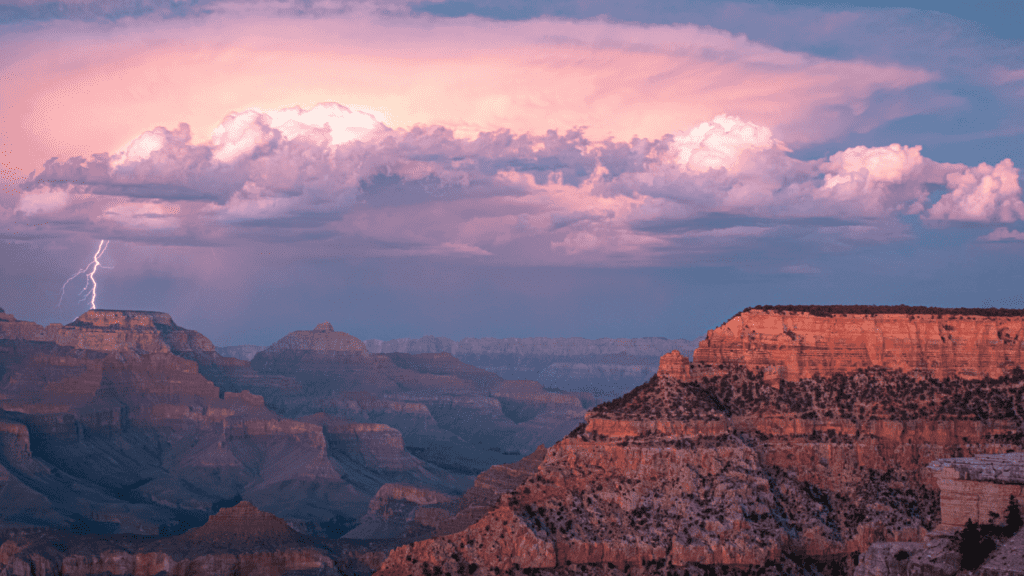- Total25
- Facebook14
- Pinterest3
- Email8

You might think the Grand Canyon has been photographed so much that it's impossible to get an original shot. But look at the size of this magnificent landscape. We challenge you to find an image that is unique and eye-catching. Here are some ideas for how to shoot the Grand Canyon National Park in Arizona.

The Landscape Shots
Your gallery of images of the Grand Canyon will include scenic shots of the red rock landscape that covers miles of rugged terrain that is many millions of years old. Head to the best viewpoints, including Mather Point and Yavapai Observation Station. Lipan Point, with expansive views of the canyon and Colorado River, really shines at sunrise and sunset.
If you take a river trip, you might find yourself photographing stunning waterfalls and inviting masses of flowing water.
Wildlife
You will need patience and some luck to capture a photo of the wildlife that inhabits the awe-inspiring Grand Canyon. Keep an eye out for the smallest creatures like reptiles, birds, and vermin, and beware of dangerous mountain lions and coyotes. Cuter creatures like deer and sheep also live in the Grand Canyon area. Do you know which animal most commonly attacks canyon visitors, including nature photographers who get too close? It is the red rock squirrel that looks adorable but can be ferocious.

Lifestyle
Documentary-style or lifestyle photography can add an interesting dynamic to your gorgeous Grand Canyon gallery. Photos en route to the destination, action shots while hiking, reaching the top of a peak, or something as simple as drinking water can paint a picture of what it was like being at one of America's most popular tourist destinations.

People To Show Scale
People are a great way to demonstrate the sheer size of rocks in the Grand Canyon. If you see tourists wandering along the path, snap some images to give your viewer a realistic idea of how massive the cliff, rocks or mountain is. If you have a travel companion who can act as a model, even better. If you want your model to stand out, bring clothing that contrasts rather than blends in with the natural surroundings to make your photo pop as well as demonstrate scale.
Trees are another way to show scale and often add an interesting layer to imagery while keeping it natural. Look for trees that give contrast to the surroundings with the colors or shape their form.

Abstract
The beautiful shapes and colors of the rocks are ideal for some creative abstract photography. Capture the smooth and jagged shapes of various rock formations and the shades of browns, reds, and oranges of the earthy landscape.
Details
After you have used your standard or wide-angle lens to capture stunning vertical and horizontal images of the south and north rim scenes, look around for detail shots that might require a macro lens if you are carrying it. Shoot trees, cactus, leaves, footprints, textures, cracks and patterns in rocks and other interesting details Mother Nature has left just for you.

Signage
You will see signs dotted around the Grand Canyon, and they can offer an interesting perspective and give information to your viewer. Safety warnings, distances and place names all add a depth to your canyon gallery that helps tell the story of your adventure.

Your Camera Bag
Once you get to the Grand Canyon, there's no going back, so make sure you have two camera bodies, filters, plenty of batteries and memory cards, a quality tripod and the lenses you plan on using. A wide-angle and standard lens would be recommended as the most basic lens kit.
Timing
Getting up early to witness the most beautiful light and avoid crowds is worth the effort. Take your time photographing the many beautiful scenes you find. The light is constantly changing and sometimes lingering in one place can have rewards. Sunset is also a stunning time of the day to take photos.
Watch the weather, which can bring dramatic scenes, including moody views, dramatic skies, and unexpected blessings with rain and lighting. If you meet locals during your Grand Canyon travels, ask them for the best spots for photos and see if you might get led off-the-beaten-track to an unexpectedly inspiring area for your photoshoot. Be sure to take some portraits of the person who helped you too. It will only take a few moments and will help trigger your memories of this most fabulous photo exploration later on.
Also, keep in mind the seasons can bring some fascinating changes, so if you love photographing the Grand Canyon, you might need to go several times. For example, pretty wildflowers bloom on the North Rim in May and June. In October, you can see maple trees looking postcard-perfect. In winter, you can still visit the South Rim (the North Rim is closed).

Being Safe And Being Sensible
The Grand Canyon can be a harsh environment to explore, and the weather can be unpredictable. So aside from your camera gear, make sure you have all the essentials including:
- Food and water
- Appropriate clothing with good walking shoes and a hat
- Phone with spare batteries
- Medication and first aid kit
Stay hydrated, don't take risks like getting too close to cliff edges to get epic photos and always stay with your group or travel companion. Let friends and family know your travel plans, including where you are going and when you will be back. Always use your common sense and stay alert.
We hope you have fun exploring the Grand Canyon with your camera. National Geographic moments are out there in the epic wilderness of this vibrant-colored canyon. We can't wait to see your work!
- Total25
- Facebook14
- Pinterest3
- Email8




